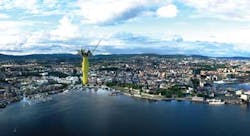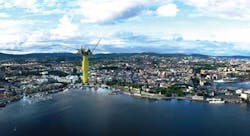Aker Solutions has been awarded a FEED (front-end engineering and design) contract from Statoil to design the world's largest spar platform for the Aasta Hansteen field development in the Norwegian Sea.
With a total hull length of 193 m (633 ft) and a draft of 170 m (558 ft), theAasta Hansteen (formerly named Luva) spar platform will be the largest of its kind, the first spar on the Norwegian continental shelf (NCS), and the world's first spar with condensate storage capacity -- a so called belly-spar.
The belly-spar concept is an exclusive Aker Solutions design. The "belly" refers to the increased diameter of part of the circular shaped hull, where the condensate storage tanks are located, giving belly-spar its characteristic shape.
"The Aasta Hansteen Spar will be the first production platform on the NCS with steel catenary risers," said Henning Østvig, head of Front-End & Technology in Aker Solutions. "With a water depth of 1,300 meters, this is probably the only riser technology that can meet the challenges on the Aasta Hansteen field."
The catenary risers are made of self-supporting steel pipes in a bow shape between the platform and the seabed. The shape helps the risers compensate for the motions on the floating facility.
"The Belly-Spar concept is a result of the innovative spirit and culture among our engineers, who have come up with the right solutions for the challenging conditions on the Aasta Hansteen field," said Valborg Lundegaard, head of Engineering business area for Aker Solutions.
The mooring system forAasta Hansteen consists of a set of polyester lines.
"There are currently no installations on the NCS with polyester mooring," said Østvig. "Aasta Hansteen may be the first, and it will definitely be operating in the deepest water."
The FEED study will be completed in 3Q 2012. The contract value is undisclosed.
The Aasta Hansteen field was discovered in 1997 and lies 300 km (186 mi) offshore in the Vøring area. The license partners are Statoil (75%), ExxonMobil (15%), and ConocoPhillips (10%).
Daewoo awards Aker drilling equipment contracts
Meanwhile, Aker Solutions has received a letter of award from Daewoo Shipbuilding & Marine Engineering to supply a further two drilling equipment packages to the Cat D drilling rigs the yard is building for the rig operator Songa Offshore.
The development of the Cat D semisubmersible drilling rigs was initiated by Statoil. The Cat D rig is a new generation drilling and well intervention vessel, purpose made for the needs of North Sea operations. The first contract, for two drilling equipment packages, was announced last summer.
The two units will be delivered in 2015. The contract includes topside drilling equipment, procurement, and commissioning of the rigs at the DSME yard.
"The development of the new rig concept has been enabled by combination of Aker Solutions' field-proven equipment and systems expertise, and our flexible and competent engineering capabilities," said Thor Arne Håverstad, head of Aker Solutions' drilling technologies business. "We look forward to extend and continue the strong cooperation with DSME, Songa, and Statoil."
Baker Hughes adds frac, stim vessel
A subsidiary of Baker Hughes has chartered a new state-of-the-art pressure pumping vessel that will provide offshore stimulation services to Maersk Oil in the North Sea. Upon completion, scheduled for late 2013, theBlue Orca will become the eighth vessel in the Baker Hughes fleet.
TheBlue Orca will be rated to 15,000 psi and will offer among the largest fluid and proppant carrying capacities in the world. It will provide 15,000 hp hydraulic pumping capacity and the ability to pump at rates well in excess of 60 bpm. Engineering work on the marine and stimulation systems has already begun.
"Stimulation of long horizontal wells is one of Maersk Oil's key technologies and vital for economic development of our tight chalk reservoirs," said Mary Van Domelen, Maersk Oil's stimulation team leader. "We appreciate the opportunity to work with Baker Hughes to deliver a new state-of-the-art stimulation vessel and look forward to welcoming theBlue Orcato the North Sea."
TheBlue Orca will join Baker Hughes' other stimulation vessels – including the company's newest additions to the Gulf of Mexico: Blue Tarpon and the Blue Dolphin. The vessels support offshore completion operations and will be equipped to support high-rate and high-volume multi-zone fracturing operations, the company says.
"Our pressure pumping vessels offer enhanced safety systems with redundant back-up blending and pumping capabilities," said Lindsay Link, Baker Hughes' president of Pressure Pumping.
BP awards Technip $792-million contract
Technip has won its largest UK offshore contract to date, valued at around $792 million, for work at BP's Quad 204 project west of Shetland.
BP is replacing the existing Schiehallion production floater with a new FPSO, and is installing extensive new subsea infrastructure. The aim is to recover an additional 450 MMbbl of reserves and to extend production through 2035.
Technip UK will:
- Remove the existing FPSO and mooring system
- Recover all existing flexible risers and dynamic umbilical systems
- Position and install the new FPSO and associated mooring system and anchor piles
- Supply and install 21 dynamic flexible risers
- Install four static and dynamic umbilicals
- Coat, weld, and install 15 steel pipelines, with a total length of 50 km (31 mi)
- Provide and install flexible jumpers
- Install manifolds, jumpers, and infrastructure.
Offshore work should start in 2013. Technip's office near Aberdeen will manage the contract, while the company's spoolbase in Evanton, northern Scotland, will fabricate the 15 steel pipelines. The Le Trait facility in northern France will manufacture all flexible pipelines.
Various vessels from Technip's fleet will execute the installations, and they too will be managed from the Aberdeen office.
Offshore Articles Archives
View Oil and Gas Articles on PennEnergy.com

